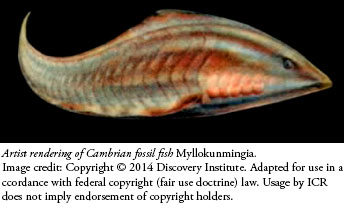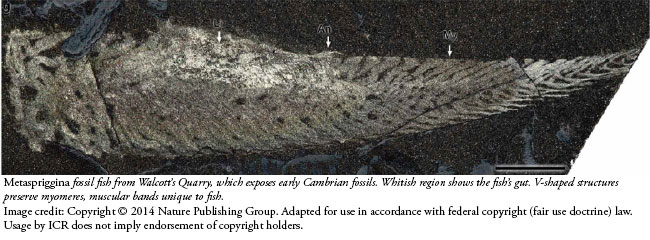New fossil finds further verify one of evolution's biggest problems: the Cambrian explosion. According to evolutionary reckoning, a massive explosion of new life supposedly spawned dozens of brand-new fully formed body plans about 530 million years ago. How could so many novel body plans emerge in such a short time while today's emergence rate of new body plans is zero? Details from newly discovered Canadian fossil fish intensify this Cambrian conundrum.1
Very few fossils show up in rock layers below the Cambrian—some sponges, cnidarians, a mollusk, what look like worm trails, and several fossils now reclassified as non-animals, known as the Ediacaran fauna. Then, suddenly, most of the basic animal forms occur in Cambrian rocks, including echinoderms (e.g., starfish), various arthropods including shrimp and sea scorpions, clams, brachiopods, annelid worms, and chordates—a group of animals including vertebrates like fish.
This fossil pattern falls afoul of evolutionary expectations. Simpler animals in lower rocks, from supposedly earlier times, evolved into more complicated animals like chordates and those should appear in upper rock layers according to evolution. Instead, most fundamental animal forms classified as phyla, occur in lower Cambrian strata. In other words, instead of a slow and gradual appearance of new life forms, the fossils show just the opposite: the sudden appearance of fully-formed creatures.
Some have resisted interpreting fossils of jawless fish from Chinese Cambrian rocks as representing true chordates. But new finds from Canada validate them as vertebrates.
 Over a decade ago, Chinese paleontologists described the earliest known fossil fish, including one named Myllokunmingia found in Chengjiang, China. Because the fish were recovered from lower Cambrian strata, they suggested that rates of evolution at that time must have been exceptionally fast.
Over a decade ago, Chinese paleontologists described the earliest known fossil fish, including one named Myllokunmingia found in Chengjiang, China. Because the fish were recovered from lower Cambrian strata, they suggested that rates of evolution at that time must have been exceptionally fast.
Like modern fish, Myllokunmingia had W-shaped muscle bundles called myomeres, and a fully developed gut. Some acknowledge that evolution could never invent such specified complexity in such short time, so they initially doubted the Chinese discoveries, hypothesizing that the finds were simplistic evolutionary precursors of fully formed fish.
BBC News reported in 1999, "The discoveries, made by two separate teams, date from the Lower Cambrian era. This is 50 million years before the current estimate of when fish evolved, at about 530 million years ago."1
Aside from the rocks in Chengjian, Some reasoned that if chordates really existed during the Cambrian, they should also occur in Cambrian rocks outside China, for example the Burgess Shales of British Columbia. Well, they do now. New descriptions of fish in the Cambrian strata of North America prove it.

Researchers publishing in Nature noted that this Canadian fossil Cambrian fish named Metaspriggina walcotti looks very similar to the Chinese fossil Myllokunmingia fengjiaoa.2
The study authors wrote, "Although the myomeral configuration is also similar to Haikouichthys, in Metaspriggina the additional ventral chevron and clear dorsal bend define a W-shaped arrangement directly comparable to fish."2 Haikouichthys, another Chinese Cambrian fish, looked like a small hagfish.
So, fully formed fish occur in both Chinese and Canadian Cambrian layers. This means the evolutionary problem of the Cambrian explosion is real and intense.
Reams of new information in the form of biological coding, represented by dozens of novel cell types in Cambrian fossils, demand a reasonable cause. A Precambrian sponge would have had five cell types, but the Cambrian fish had 60 cell types, equivalent to an encyclopedia of brand-new biological information.3
Plus, over 67 percent of animal phyla have their lowest occurrence in the Cambrian.4 That's a lot of new animals suddenly appearing fully formed, and those same body plans have not changed.
If evolution is not adding new suites of biological information to any of today's creatures, then how could it have added so much, so fast, so long ago? Whereas the Canadian Cambrian fish Metaspriggina certainly punctuates this longstanding and unanswered challenge to evolution's defenders, it follows nicely from the biblical concept that Cambrian rocks represent the first of many Flood deposits, burying creatures that God had purposely fashioned.
References
- Oldest fossil fish caught. BBC News. Posted on news.bbc.co.uk November 4, 1999, accessed September 10, 2014.
- Morris, S. C. and J.B. Caron. 2014. A primitive fish from the Cambrian of North America. Nature. 512 (7515): 419-422.
- Meyer, S. C., M. R. Ross, and P. A. Nelson, P. Chien. 2003. The Cambrian Explosion: Biology's Big Bang. In Darwinism, Design, and Public Education, edited by S.C. Meyer and J.A. Campbell. Michigan State Press, 336.
- Ibid, 352.
Image credit: Copyright © International Business Times. Adapted for use in accordance with federal copyright (fair use doctrine) law. Usage by ICR does not imply endorsement of copyright holders.
* Mr. Thomas is Science Writer at the Institute for Creation Research.
Article posted on September 26, 2014.













